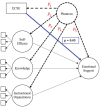Using Simulated Annealing to Investigate Sensitivity of SEM to External Model Misspecification
- PMID: 36601254
- PMCID: PMC9806519
- DOI: 10.1177/00131644211073121
Using Simulated Annealing to Investigate Sensitivity of SEM to External Model Misspecification
Abstract
Sensitivity analyses encompass a broad set of post-analytic techniques that are characterized as measuring the potential impact of any factor that has an effect on some output variables of a model. This research focuses on the utility of the simulated annealing algorithm to automatically identify path configurations and parameter values of omitted confounders in structural equation modeling (SEM). An empirical example based on a past published study is used to illustrate how strongly related an omitted variable must be to model variables for the conclusions of an analysis to change. The algorithm is outlined in detail and the results stemming from the sensitivity analysis are discussed.
Keywords: metaheuristic algorithms; optimization; sensitivity analysis; simulated annealing; structural equation modeling.
© The Author(s) 2022.
Conflict of interest statement
The authors declared no potential conflicts of interest with respect to the research, authorship, and/or publication of this article.
Figures





References
-
- Bollen K. A. (1989). Structural equations with latent variables. John Wiley.
-
- Brown J., Winsor D. L., Blake S. (n.d.). Technology and social-emotional development in the early childhood environments. In Child development and the use of technology (pp. 112–128). IGI Global. https://doi.org/10.40182F978-1-61350-317-1.ch006
-
- Fouskakis D., Draper D. (2002). Stochastic optimization: A review. International Statistical Review, 70, 315–349.
-
- Hancock G. R., Mueller R. O. (2019). Structural equation modeling. In Hancock G. R., Stapleton L. M., Mueller R. O. (Eds.), The reviewer’s guide to quantitative methods in the social sciences (2nd ed., pp. 445–456). Routledge.
-
- Harring J. R., McNeish D. M., Hancock G. R. (2017). Using phantom variables in structural equation modeling to assess model sensitivity to external misspecification. Psychological Methods, 22, 616–631. - PubMed
LinkOut - more resources
Full Text Sources
Miscellaneous
